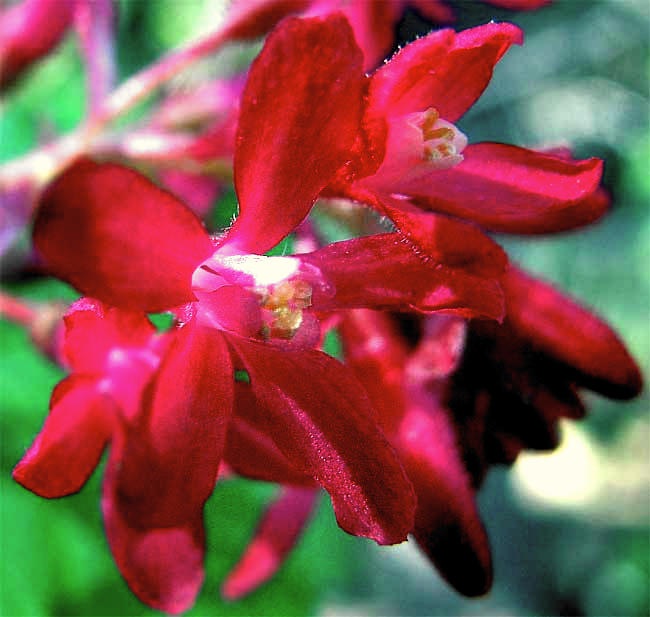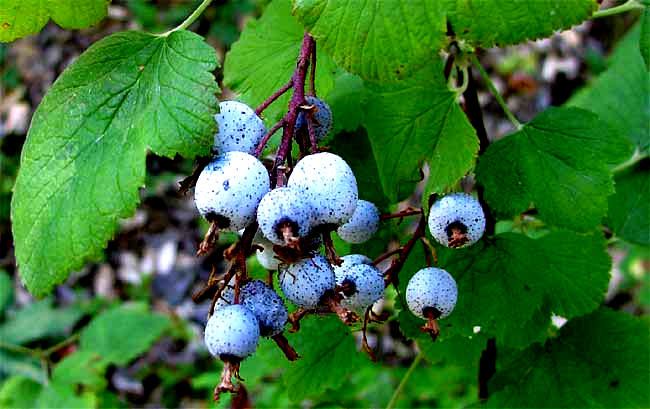Excerpts from Jim Conrad's
Naturalist Newsletter
from the April 26, 2009 Newsletter, issued from the Siskiyou Mountains west of Grants Pass, Oregon:
FLOWERING CURRANT
On an overnight camping trip this week maybe the most unexpectedly pretty plant encountered was a diffuse bush with freshly emerged flowers and leaves about ten feet tall and growing in a deeply shaded, mossy-sloped moist ravine. As I approached its shadowy, sheltered cove, the bush rose in a shaft of sunlight surrounded by darkness. Its crimson racemes of inch-long flowers and veiny leaves were presented like a bouquet on display beneath a spotlight. You can see part of it below:

It was the Flowering Currant, RIBES SANGUINEUM, a popular garden shrub in many parts of the world, but here growing wild, for its natural distribution is the coastal zone from central British Columbia to central California, so we're in the heart of its native land. Many cultivars have been developed, with flowers ranging from white to dark red.
For most flowers the corolla is the colorful part, but with this species the largest and most colorful segments are the sepals (calyx lobes) and the bracts. In the picture, notice that there's one bract, or modified leaf, at the base of each flower stem, or pedicel. The petal-like sepals are better seen below:

In that picture the corollas of two flowers show up as pale, cylindrical structures arising from the center of the stars formed by the flaring, red sepals. Cream-colored anthers of four or five male stamens are visible at each corolla's mouth.
The genus Ribes is divided into two big groups, the gooseberries and the currants. Gooseberries and currants used to occupy different genera but now it's recognized that there's not really much difference between them. Most people think of gooseberry bushes as having spines while current bushes don't. Also, gooseberry bushes usually produce flower clusters, or inflorescences, of only one to three blossoms, while the inflorescences of currant species usually hold four or more blossoms. Our Flowering Currant produces a dark purple, edible fruit less than half an inch long, but it's fairly tasteless and people generally don't bother eating it.
When I was in the university they taught that Ribes belonged to the Saxifrage Family but now it's granted its own family, the Current or Gooseberry Family, the Grossulariaceae, which consists of just this one genus, Ribes. About 150 gooseberry and currant species are recognized in the genus Ribes, and the genus is restricted to temperate parts of the Northern Hemisphere.
Interestingly, some states prohibit growing Ribes species because they serve as an alternate host for the fungus causing White Pine Blister Rust.
from the August 23, 2009 Newsletter, issued from the Siskiyou Mountains west of Grants Pass, Oregon:
FLOWERING CURRANT FRUITING
Now our Flowering Currants bear the fruits shown below:

You can see the fruits' special features below:

The fruit, a many-seeded berry, is covered with short, glandular hairs. Sticky glands might dissuade insects from wandering across the fruit's surface, eating it or laying eggs in it. Also notice how the old flower's corolla tube, or hypanthium, has remained atop the ovary as it enlarged and matured, and now is fairly permanently stuck to the fruit. Who knows why currants think they need to do this?
The base color of the pea-size berries is dark blue-black. That's the color you get if you rub the fruit's surface with a finger, for the pale, silveriness wipes off. Many fruits and leaves are covered with such a "bloom" that can be wiped off. Technically the pale bloom is referred to as glaucousness.
The fruits are edible but not so flavorful. Birds appreciate them much more than humans.